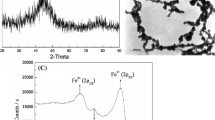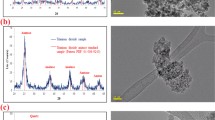Abstract
In this study, we assessed the transportability of zero valent iron nanoparticles (nano-Fe0) coated with different organics (carboxy methyl cellulose (CMC), poly acrylic acid (PAA), and xanthan gum) in standard porous sand and in real aquifer sediments. Our results suggest that the organic surface coatings optimized for nano-Fe0 in porous sand media do not necessarily reflect the same transportability in real field aquifer sediment. Xanthan gum-coated nano-Fe0 showed highest transportability in standard porous sand, but the performance was much lower in real aquifer sediment, whereas the PAA-coated nano-Fe0 particle showed better transportability both in aquifer sediment and in porous sand media. Nano-Fe0 without organic surface coating exhibited very low transportability and was largely retained by the porous medium. Our results suggest that the molecular weight and surface charge density of the organic may play a role in transportability of these nanoparticles. To assess the impact of organic coating on the nanoparticle reactivity with contaminants, we also conducted batch tests to follow TCE degradation using different surface coatings and found no significant difference albeit a minor delay in kinetics. Using theoretical calculations, we also estimated the potential distance traveled by nanoparticles in porous sand as well as in aquifer sediment. Our results suggest that using xanthan gum and PAA as surface coating, nano-Fe0 could travel up to 9.8 and 4.1 m, respectively, in the porous sand media as compared to 0.2 and 0.9 m in real aquifer sediment, respectively.

Nanoparticle mobility in porous sand vs and aquifer sediment.






Similar content being viewed by others
References
Abbassi R, Yadav AK, Kumar N, Huang S, Jaffe PR (2013) Modeling and optimization of dye removal using “green clay” supported iron nano-particles. Ecol Eng 61:366–370
Allen CN, Lequeux N, Chassenieux C, Tessier G, Dubertret B (2007) Optical analysis of beads encoded with quantum dots coated with a cationic polymer. Adv Mater 19:4420–4425
Basnet M, Ghoshal S, Tufenkji N (2013) Rhamnolipid biosurfactant and soy protein act as effective stabilizers in the aggregation and transport of palladium-doped zero valent iron nanoparticles in saturated porous media. Environ Sci Technol 47:13355–13364
Basnet M, Tommaso CD, Ghoshal S, Tufenkji N (2015) Reduced transport potential of a palladium-doped zero valent iron nanoparticle in a water saturated loamy sand. Water Res 68:354–363
Busch J, Meibner T, Pothoff A, Oswald SE (2014) Investigations on mobility of carbon colloid supported nanoscale zero-valent iron (nZVI) in a column experiment and a laboratory 2D-aquifer test system. Environ Sci Pollut Res 21:10908–10916
Comba S, Sethi R (2009) Stabilization of highly concentrated suspensions of iron nanoparticles using shear-thinning gels of xanthan gum. Water Res 43:3717–3726
Elimelech M, Gregory J, Jia X, Williams R (1995) Particle deposition and aggregation: measurement, modeling and simulation. Butterworth-Heinemann, Boston
Elliot JE, Macdonald M, Nie J, Bowman CN (2004) Structure and swelling of poly(acrylic acid) hydrogels: effect of pH, ionic strength, and dilution on the crosslinked polymer structure. Polymer 45:1503–1510
Fritz G, Schädler V, Willenbacher N, Wagner NJ (2002) Electrosteric stabilization of colloidal dispersions. Langmuir 18:6381–6390
Han Y, Shi N, Wang H, Pan X, Fang H, Yu Y (2016) Nanoscale zerovalent iron-mediated degradation of DDT in soil. Environ Sci Pollut Res 23:6253–6263
He F, Zhao D (2007) Manipulating the size and dispersibility of zerovalent iron nanoparticles by use of carboxymethyl cellulose stabilizers. Environ. Sci. Technol. 41:6216–6221
Hydutsky BW, Mack EJ, Beckerman BB, Skluzacek JM, Mallouk TE (2007) Optimization of nano- and nicroiron transport through sand columns using polyelectrolyte mixtures. Environ. Sci. Technol. 41:6418–6424
Jamieson AM, Southwick JG, Blackwell J (1982) Dynamical behavior of xanthan polysaccharide in solution. J Polym Sci 20:1513–1524
Kaifas D, Malleret L, Kumar N, Fétimi W, Claeys-Bruno M, Sergent M, Doumenq P (2014) Assessment of potential positive effects of nZVI surface modification and concentration levels on TCE dechlorination in the presence of competing strong oxidants, using an experimental design. Sci Total Environ 481:335–342
Kanel SR, Goswami RR, Clement TP, Barnett MO, Zhao D (2007) Two dimensional transport characteristics of surface stabilized zero-valent iron nanoparticles in porous media. Environ. Sci. Technol. 42:896–900
Kosmulski M (2011) The pH-dependent surface charging and points of zero charge V. Uptake. J. colloid interf. Sci. 353:1–15
Kumar N, Auffan M, Gattacceca J, Rose J, Olivi L, Borschneck D, Kvapil P, Jublot M, Kaifas D, Malleret L, Doumenq P, Bottero J-Y (2014a) Molecular insights of oxidation process of iron nanoparticles: spectroscopic, magnetic, and microscopic evidence. Environ. Sci. Technol. 48:13888–13894
Kumar N, Omoregie EO, Rose J, Masion A, Lloyd JR, Diels L, Bastiaens L (2014b) Inhibition of surface reducing bacteria in aquifer sediment by iron nanoparticles. Water Res 51:64–72
Kumar N, Millot R, Battaglia-Brunet F, Omoregie E, Chaurand P, Borschneck D, Bastiaens L, Rose J (2016) Microbial and mineral evolution in zero valent iron-based permeable reactive barriers during long-term operations. Environ Sci Pollut Res 23:5960–5968
Labille J, Thomas F, Milas M, Vanhaverbeke C (2005) Flocculation of colloidal clay by bacterial polysaccharides: effect of macromolecule charge and structure. J colloid interf Sci 284:149–156
Laguecir A, Ulrich S, Labille J, Fatin-Rouge N, Stoll S, Buffle J (2006) Size and pH effect on electrical and conformational behavior of poly(acrylic acid): simulation and experiment. Eur Polym J 42:1135–1144
Laumann S, Micic V, Lowry GV, Hofman T (2013) Carbonate minerals in porous media decrease mobility of poluacrylic acid modified zero-valent iron nanoparticles used for groundwater remediation. Environ Pollut 179:53–60
Lecoanet HF, Bottero J-Y, Wiesner MR (2004) Laboratory assessment of the mobility of nanomaterials in porous media. Environ. Sci. Technol. 38:5164–5169
Liu Y, Majetich SA, Tilton RD, Sholl DS, Lowry GV (2005) TCE dechlorination rates, pathways, and efficiency of nanoscale iron particles with different properties. Environ. Sci. Technol. 39:1338–1345
Louie MS, Tilton RD, Lowry GV (2016) Impacts of macromolecular coatings on critical physicochemical processes controlling environmental fate of nanomaterials. Environmental Science: nano 3:283–310
McCurrie R (1994) Ferromahnetic materials: structure and properties. Academic Press, London
Milas M, Rinaudo M (1986) Properties of xanthan gum in aqueous solutions: role of the conformational transition. Carbohyd Res 158:191–204
Nurmi JT, Tratnyek PG, Sarathy V, Baer DR, Amonette JE, Pecher K, Wang C, Linehan JC, Matson DW, Penn RL, Driessen MD (2004) Characterization and properties of metallic iron nanoparticles: spectroscopy, electrochemistry, and kinetics. Environ. Sci. Technol. 39:1221–1230
Phenrat T, Saleh N, Sirk K, Tilton RD, Lowry GV (2006) Aggregation and sedimentation of aqueous nanoscale zerovalent iron dispersions. Environ. Sci. Technol. 41:284–290
Phenrat T, Saleh N, Sirk K, Kim H-J, Tilton R, Lowry G (2008) Stabilization of aqueous nanoscale zerovalent iron dispersions by anionic polyelectrolytes: adsorbed anionic polyelectrolyte layer properties and their effect on aggregation and sedimentation. J Nanopart Res 10:795–814
Saleh N, Sirk K, Liu Y, Phenrat T, Dufour B, Matyjaszewski K, Tilton RD, Lowry GV (2007) Surface modifications enhance nanoiron transport and NAPL targeting in saturated porous media. Environ Eng Sci 24:45–57
Schrick B, Hydutsky BW, Blough JL, Mallouk TE (2004) Delivery vehicles for zerovalent metal nanoparticles in soil and groundwater. Chem Mater 16:2187–2193
Solovitch N, Labille J, Rose J, Chaurand P, Borschneck D, Wiesner M, Bottero J-Y (2010) Concurrent aggregation and deposition of TiO2 nanoparticles in a sandy porous media. Environ. Sci. Technol. 44:4897–4902
Strutz TJ, Hornbruch G, Dahmke A, Köber R (2016) Influence of permeability on nanoscale zero-valent iron particle transport in saturated homogeneous and heterogeneous porous media. Environ Sci Pollut Res 23:17200–17209
Sun Y-P, Li X-Q, Zhang W-X, Wang HP (2007) A method for the preparation of stable dispersion of zero-valent iron nanoparticles. Colloid Surface A 308:60–66
Thomas F, Prélot B, Villiéras F, Cases J-M (2002) Electrochemical properties of solid at the aqueous-solid interface and heterogeneity of surface. C.R. Geosci 334:633–648
Tratnyek PG, Johnson RL (2006) Nanotechnologies for environmental cleanup. Nano Today 1:44–48
Tufenkji N, Elimelech M (2004) Correlation equation for predicting single-collector efficiency in physiochemical filteration in saturated porous media. Environ. Sci. Technol. 38:529–536
Vecchia ED, Luna M, Sethi R (2009) Transport in porous media of highly concentrated iron micro- and nanoparticles in the presence of xanthan gum. Environ Sci Technol 43:8942–8947
Velimirovic M, Schmid D, Wagner S, Micic V, Von der Kammer F, Hofmann T (2015a) Agar agar-stabilized milled zerovalent iron particles for in situ groundwater remediation. Sci Total Environ 563-564:713–723
Velimirovic M, Simons Q, Bastiaens L (2015b) Use of CAH-degrading bacteria as test-organism for evaluating the impact of fine zerovalent iron particles on the anaerobic subsurface environment. Chemosphere 134:338–345
Yang GCC, Tu H-C, Hung C-H (2007) Stability of nanoiron slurries and their transport in the subsurface environment. Sep Purif Technol 58:166–172
Zhang W-x (2003) Nanoscale iron particles for enviromental remediation: an overview. J Nanopart Res 5:323–332
Zhivkov AM, Hristov RP (2015) Adsorption of carboxymethyl cellulose on alumina particles. J Colloid Interf Sci 447:159–166
Acknowledgments
Authors are thankful to SERPOL for providing us the aquifer sediment from the site. This research received funding from the European Union’s Seventh Framework Programme FP7/2007-2013 NanoRem under grant agreement number 309517 (Article II.30 GA) and the French national research agency ANR via the NANOFREZES project. The authors thank the CNRS for funding the GDRi-iCEINT. This work is also a contribution to the Labex Serenade (ANR-11-LABX-0064) funded by the «Investissements d’Avenir» French Government program of the French National Research Agency (ANR) through the A*MIDEX project (ANR-11-IDEX-0001-02).
Author information
Authors and Affiliations
Corresponding author
Additional information
Responsible editor: Philippe Garrigues
Electronic supplementary material
ESM 1
(DOCX 8169 kb)
Rights and permissions
About this article
Cite this article
Kumar, N., Labille, J., Bossa, N. et al. Enhanced transportability of zero valent iron nanoparticles in aquifer sediments: surface modifications, reactivity, and particle traveling distances. Environ Sci Pollut Res 24, 9269–9277 (2017). https://doi.org/10.1007/s11356-017-8597-1
Received:
Accepted:
Published:
Issue Date:
DOI: https://doi.org/10.1007/s11356-017-8597-1




